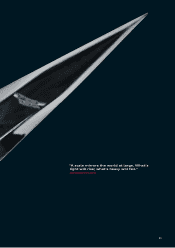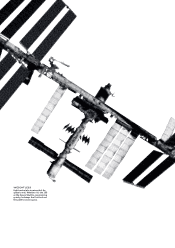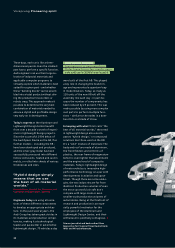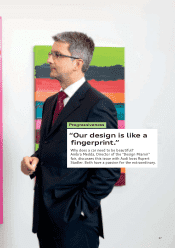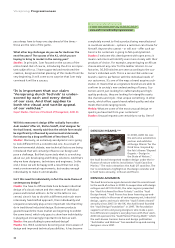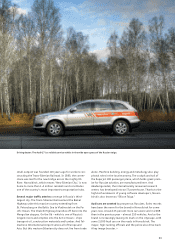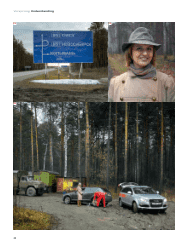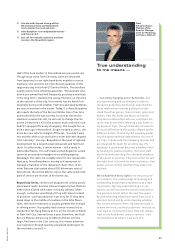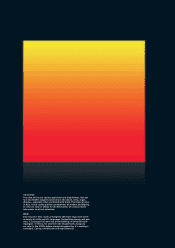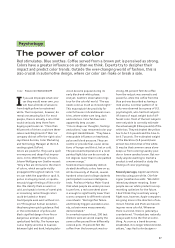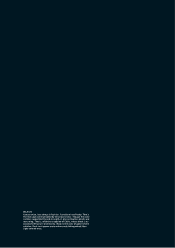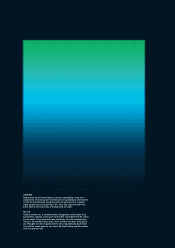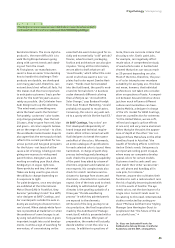Audi 2008 Annual Report Download - page 35
Download and view the complete annual report
Please find page 35 of the 2008 Audi annual report below. You can navigate through the pages in the report by either clicking on the pages listed below, or by using the keyword search tool below to find specific information within the annual report.
31
The New Museum of
Contemporary Art in
New York is considered
to be one of the world’s
leading addresses
for contemporary art.
Stadler: I think this is a positive development. At Audi,
form traditionally follows function. Function is an obliga-
tion for us. In this respect, we follow the tradition of mod-
ernism wholeheartedly – we only come up with something
interestingly new when there is a perfect interplay between
designers and engineers.
What feeds inspiration for designing new Audi models?
Stadler: The role our company’s history plays should not
be underestimated. We continue to draw on a specific de-
sign language from our past and develop it further and
further. In this way we are able to build an esthetic bridge
to the past and the tradition of our brand.
The Audi design language has also been an extremely
German design from the very beginning. Why?
Stadler: Our culture is heavily influenced by technology.
Craftsmanship, precision and ingenuity mean something in
Germany. At the same time, our cultural proximity to
Mediterranean countries, especially Italy, is very obvious.
Our longing for the country beyond the Alps has always
made its esthetic mark here. Today, we believe this mix –
this fusion of technology and beauty – is characteristic of
our vehicles. It reflects not only how much the product, but
also the country, continent and its people have changed.
Medda: But what matters is that the product also has a
past. This is always a good basis for a truly sophisticated
and creative design. An object shouldn’t necessarily look
“designed,” it should just look good – timeless and without
frills. That’s what we mean when we talk about a modern
classic. Such a title is the best design can hope to achieve.
Photos: AUDI AG, Dean Kaufmann/New Museum
Dr. Dominik Wichmann, journalist and book author, is the editor-
in-chief of the multi-award winning Süddeutsche Zeitung magazine.
He is considered one of Germany’s most creative chief editors.
the strangest was an order we received years ago from an
A8 customer for Nogaro Blue Alcantara trim and a match-
ing dress of the same material, a request she made when
ordering the car. She then wore this dress when she came
to collect her car. As everybody knows, there is no account-
ing for taste. So, for a surcharge, any customer can have his
car delivered according to his individual wishes and ideas.
Ms. Medda, as a design expert, do you view such develop-
ments with a certain amount of esthetic skepticism?
Medda: Of course, not everything people put together re-
flects my own personal taste. But that’s not the point here.
What is more important here is that design is becoming in-
creasingly anchored in society. No longer is it just some ex-
otic hobby pursued by certain curators and older couples
who eat prawn cocktails at design exhibitions. The design
debate is finally back on the agenda. Design has regained
its relevance.
Stadler: You have played a significant part in this with the
Design Miami/ fair.
Medda: Certainly not on my own. But the fair does provide
a platform for anyone who is committed to a contemporary
understanding of design and is passionate about it. Of course,
that is above all the artists and designers themselves. Exhi-
bitions are not only about sales; they are about providing a
platform for a substantive discussion on the subject. New-
comers are promoted; stars of the scene are honored.
Are you finding that the trend is more about content and
less about simple design language?
Medda: Certainly content is playing an increasing role in
contemporary design, which is only natural given the in-
creased emphasis on craftsmanship. Pure surface design
is no longer enough.


